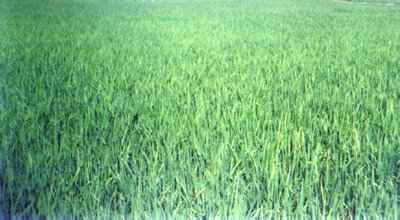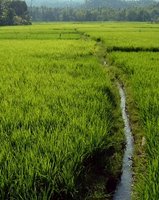Without Drought!

Everybody loves a good drought. The way farmers in Maharshtra are committing suicide every day and the way government packages are flying off the exchequer only to land in wrong hands, P. Sainath should be smiling. He has more than necessary to produce the sequel. However, he might have to mull over the title this time as “Everybody Loves A Good Drought –II” may no more be relevant.
And a look at the paddy growers of Champaran in Bihar will tell you that. Paddy has traditionally been the prime crop in this north-eastern district of Bihar because of the very fertile alluvial soil brought by the rivers that feed this land. The district also has rarely faced a drought in the past two decades and generally receives good rains during the Monsoons. All extremely favourable conditions for paddy cultivation. However, the farmer is not happy. Of late, many of his clan have been slowly shifting to sugarcane farming. In fact, today’s paddy farmer is more distressed than he was in the 1980s, despite the fact that India has “developed” by leaps and bounds in the past two decades.
Why? What’s ailing him after all? A simple economic break up of paddy cultivation might have an answer. The paddy season starts in April-May when the farm is prepared and seeds are sown. This is followed by sowing of saplings and spraying of fertilizers and insecticides. The crop is ready for harvest in September-October and after sifting of the grain from the hay, it is ready for the market. This period of six-seven months not only demands lot of hard work but also good lot of money.
The Cost:
On an average, one bigha (a local measurement equal to 1.5 acres) of land for the cultivation of normal paddy (i.e. not Basmati or any special variety) demands:
Rs 2,000 — Tractor cost (including fuel, driver and depreciation)
Rs 3,200 — Labour (except for harvest)
(It is important to note here that a male labourer is paid Rs 50/day while a female labourer Rs 20-30/day, despite government rates being Rs 71/day)
Rs 1,900 — Fertilisers (urea, DAP, Zink and others)
Rs 800 — Insecticides (including one sprayed before sowing)
Rs 450 — Seeds
And a look at the paddy growers of Champaran in Bihar will tell you that. Paddy has traditionally been the prime crop in this north-eastern district of Bihar because of the very fertile alluvial soil brought by the rivers that feed this land. The district also has rarely faced a drought in the past two decades and generally receives good rains during the Monsoons. All extremely favourable conditions for paddy cultivation. However, the farmer is not happy. Of late, many of his clan have been slowly shifting to sugarcane farming. In fact, today’s paddy farmer is more distressed than he was in the 1980s, despite the fact that India has “developed” by leaps and bounds in the past two decades.
Why? What’s ailing him after all? A simple economic break up of paddy cultivation might have an answer. The paddy season starts in April-May when the farm is prepared and seeds are sown. This is followed by sowing of saplings and spraying of fertilizers and insecticides. The crop is ready for harvest in September-October and after sifting of the grain from the hay, it is ready for the market. This period of six-seven months not only demands lot of hard work but also good lot of money.
The Cost:
On an average, one bigha (a local measurement equal to 1.5 acres) of land for the cultivation of normal paddy (i.e. not Basmati or any special variety) demands:
Rs 2,000 — Tractor cost (including fuel, driver and depreciation)
Rs 3,200 — Labour (except for harvest)
(It is important to note here that a male labourer is paid Rs 50/day while a female labourer Rs 20-30/day, despite government rates being Rs 71/day)
Rs 1,900 — Fertilisers (urea, DAP, Zink and others)
Rs 800 — Insecticides (including one sprayed before sowing)
Rs 450 — Seeds
---------------------------------------------------------------
Rs 8,350 — Total
Add to this the work of the farmer himself and one can safely assume the total cost to be Rs 9,000.
The Produce:
After deducting the payment to labour for the harvest, one bigha of land produces on an average 20 quintals (2,000 kg) of paddy. In the market, at the rate of Rs 5/kg it fetches:
Rs 10,000 — the total earning of the farmer.
(Rice from the same paddy fetches Rs 10-12 per kg in the retail market)
By simple maths, the farmer at the end of seven months of hard work makes Rs 1,000.
If he is a big farmer and has about 10 bighas (15 acres) of land, he makes Rs 10,000 in as many months. Even if we exaggerate this figure a bit, then a big farmer earns about Rs 2,000 per month.
It is not hard to imagine the plight of marginal and small farmers from these figures who are forced to work on others’ farms in addition to their’s to sustain life. But the worst affected are the landless who cultivate land on rent. A big farmer with many acres of land may rent out a few at the rate of half the produce, i.e. after the harvest, the tenant must give half of his produce to the landowner. This is in contrast to the Land Reform laws that say that a tenant is supposed to part only with one-fourth of his produce.
forced to work on others’ farms in addition to their’s to sustain life. But the worst affected are the landless who cultivate land on rent. A big farmer with many acres of land may rent out a few at the rate of half the produce, i.e. after the harvest, the tenant must give half of his produce to the landowner. This is in contrast to the Land Reform laws that say that a tenant is supposed to part only with one-fourth of his produce.
His cost:
A small farmer’s or a tenant’s cost is lesser as compared to a farmer owning lot of land. He does not use the tractor but depends on the ox-driven cultivator to prepare his land. Some of the extremely poor can even be seen pulling it themselves along with an ox as they cannot afford two. They generally do not employ labour and do all the work themselves. Thus their cost for one bigha of land (although most of them never can afford to rent one bigha and cultivate still smaller pieces of land):
Rs 1,000 — The ox and the cultivator
Rs 1,900 — Fertilisers (urea, DAP, Zink and others)
Rs 800 — Insecticides (including one sprayed before sowing)
Rs 450 — Seeds
Rs 8,350 — Total
Add to this the work of the farmer himself and one can safely assume the total cost to be Rs 9,000.
The Produce:
After deducting the payment to labour for the harvest, one bigha of land produces on an average 20 quintals (2,000 kg) of paddy. In the market, at the rate of Rs 5/kg it fetches:
Rs 10,000 — the total earning of the farmer.
(Rice from the same paddy fetches Rs 10-12 per kg in the retail market)
By simple maths, the farmer at the end of seven months of hard work makes Rs 1,000.
If he is a big farmer and has about 10 bighas (15 acres) of land, he makes Rs 10,000 in as many months. Even if we exaggerate this figure a bit, then a big farmer earns about Rs 2,000 per month.
It is not hard to imagine the plight of marginal and small farmers from these figures who are
 forced to work on others’ farms in addition to their’s to sustain life. But the worst affected are the landless who cultivate land on rent. A big farmer with many acres of land may rent out a few at the rate of half the produce, i.e. after the harvest, the tenant must give half of his produce to the landowner. This is in contrast to the Land Reform laws that say that a tenant is supposed to part only with one-fourth of his produce.
forced to work on others’ farms in addition to their’s to sustain life. But the worst affected are the landless who cultivate land on rent. A big farmer with many acres of land may rent out a few at the rate of half the produce, i.e. after the harvest, the tenant must give half of his produce to the landowner. This is in contrast to the Land Reform laws that say that a tenant is supposed to part only with one-fourth of his produce.His cost:
A small farmer’s or a tenant’s cost is lesser as compared to a farmer owning lot of land. He does not use the tractor but depends on the ox-driven cultivator to prepare his land. Some of the extremely poor can even be seen pulling it themselves along with an ox as they cannot afford two. They generally do not employ labour and do all the work themselves. Thus their cost for one bigha of land (although most of them never can afford to rent one bigha and cultivate still smaller pieces of land):
Rs 1,000 — The ox and the cultivator
Rs 1,900 — Fertilisers (urea, DAP, Zink and others)
Rs 800 — Insecticides (including one sprayed before sowing)
Rs 450 — Seeds
------------------------------------------------------
Rs 4,150 — Total
His Produce:
As he gives half his produce to the landowner, he is left with a little over 10 quintals (he harvests his produce himself). Which sells in the market for:
Rs 5,000 — His total earning
His profit adds up to about Rs 900 after seven months of hard work.
However, since no tenant tills one bigha his earning is much lesser. Normally tenants rent about 1/4th of a bigha.
It is important to note here that all these production figures are for good crops in favourable conditions. If ever the climate plays spoilsport, the production can go drastically down and a small farmer may have to starve.
The Deterioration
After all, how has the exponential growth of Indian economy in the past two decades failed to touch the farmer? Let’s understand it by simple economic breakup of the 1980/82 paddy farming:
The Cost:
Rs 600 — Tractor cost (diesel at that time cost Rs 8/litre; it now cost Rs 35/litre)
Rs 720 — Labour (except for harvest)
Rs 640 — Fertilisers (urea, DAP, Zink and others)
Rs 120 — Insecticides (including one sprayed before sowing)
Rs 150 — Seeds
Rs 4,150 — Total
His Produce:
As he gives half his produce to the landowner, he is left with a little over 10 quintals (he harvests his produce himself). Which sells in the market for:
Rs 5,000 — His total earning
His profit adds up to about Rs 900 after seven months of hard work.
However, since no tenant tills one bigha his earning is much lesser. Normally tenants rent about 1/4th of a bigha.
It is important to note here that all these production figures are for good crops in favourable conditions. If ever the climate plays spoilsport, the production can go drastically down and a small farmer may have to starve.
The Deterioration
After all, how has the exponential growth of Indian economy in the past two decades failed to touch the farmer? Let’s understand it by simple economic breakup of the 1980/82 paddy farming:
The Cost:
Rs 600 — Tractor cost (diesel at that time cost Rs 8/litre; it now cost Rs 35/litre)
Rs 720 — Labour (except for harvest)
Rs 640 — Fertilisers (urea, DAP, Zink and others)
Rs 120 — Insecticides (including one sprayed before sowing)
Rs 150 — Seeds
--------------------------------------------------------
Rs 2,230 — Total
The Production:
At the rate of Rs 3.5 per kg (i.e. Rs 350/quintal):
20 quintals X 350 = 7,000
Rs 7,000 — Total earning
Profit — Rs 5,000 approx
The Comparison
So, since 1980-82, while the cost has increased over four times, the market price of the produce has increased only marginally by 1.5 times.
God forbid if a monsoon or tow go bad in Champaran, this fertile land may become yet another graveyard. Sainath won’t feel happy while writing his book.
Rs 2,230 — Total
The Production:
At the rate of Rs 3.5 per kg (i.e. Rs 350/quintal):
20 quintals X 350 = 7,000
Rs 7,000 — Total earning
Profit — Rs 5,000 approx
The Comparison
So, since 1980-82, while the cost has increased over four times, the market price of the produce has increased only marginally by 1.5 times.
God forbid if a monsoon or tow go bad in Champaran, this fertile land may become yet another graveyard. Sainath won’t feel happy while writing his book.


